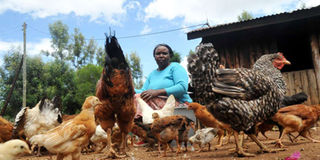Treating birds with diarrhoeal infection

A poultry farmer feeds chicken outside her house. Poultry diet contributes a lot to the colour of the birds' dropping. Birds that are fed on leafy greens like sukuma wiki or grass may have green droppings. FILE PHOTO | NMG
What you need to know:
- Cecal droppings are produced severally during the day; they originate from the cecum which is located between the birds large and small intestines.
- Any form of diarrhoea is abnormal. During heat stress, birds may consume a lot of water to cool off and may develop watery diarrhoea.
- Feed too high in protein causes wet litter as the birds ingest a lot of water to excrete uric acid.
- Diarrhoea causes damage to the wall of the bird’s intestinal lining leading to poor absorption of nutrients and water
The best way farmers can know the health status of their flock is through their droppings.
Healthy birds will appear bright and alert with smooth feathers; their droppings will be fairly solid in consistency, either green or brown in colour with a white part on top that consist of urates.
Poultry droppings will vary depending on diet, weather, cecal dropping, broody hen dropping and the health of the bird. It is, therefore, important that a farmer knows which droppings are normal and which are abnormal.
Poultry diet contributes a lot to the colour of the dropping. Birds that are fed on leafy greens like sukuma wiki (collard greens) or grass may have green droppings.
Chickens that have bathed in sand that may have been mixed with wood ash may develop dark droppings caused by ingesting the ash.
Cecal droppings are produced severally during the day; they originate from the cecum which is located between the birds large and small intestines.
Cecal dropping is reddish brown sticky in consistency and has a foul smell. This is normal dropping and farmers should not panic once they spot it.
A broody hen will sit on her eggs and will be reluctant to go out and defecate. Once she goes outside, she will release a huge pile of dropping that has a strong smell. This is also considered as normal chicken dropping.
So which is the abnormal faecal dropping?
Any form of diarrhoea is abnormal. During heat stress, birds may consume a lot of water to cool off and may develop watery diarrhoea.
A farmer should provide adequate ventilation to prevent heat stress. Chicks in a brooder will move away from the heat source and will exhibit signs of heat stress (panting, drowsy, stretched wings and diarrhoea with matting around the vent).
Reduce the heat by reducing the wattage of the bulb or raising it higher.
Other causes of diarrhoea in poultry include:
- Coccidiosis which manifests as bloody diarrhoea
- Worm infestation
- Viruses such as rota, gumboro and Newcastle among others
- Bacterial infections such as Salmonella, E. coli
- Kidney infections - white watery diarrhoea
Feed too high in protein causes wet litter as the birds ingest a lot of water to excrete uric acid. Broiler birds fed on excess protein may increase water intake by about 3 percent causing increased moisture in their droppings hence wet litter.
ALWAYS OBTAIN A VACCINATION SCHEDULE
Wet litter may lead to leg problems as birds develop wounds on their feet and breast lesions that affect the quality of the carcass.
1. Mouldy feeds contain toxins that cause poisoning of the birds. The birds will develop diarrhoea among other clinical signs. It is important that feeds are bought from a reliable source and stored in a clean and dry environment. Discard any feeds that become dump and mouldy.
2. Sudden change of feeds may cause diarrhoea that will last for a day or two. This is usually a stressful event for the birds and should be done gradually. Supplement Stressmix in their drinking water to help minimize the stress caused.
It is important that your of source drinking water is reliable. Contamination may cause infections that lead to diarrhoea in your flock.
3. Deworm your birds with Piperin once every three months. Worms rarely cause diarrhoea in birds but may cause irritation of the gut predisposing the birds to bacterial and other opportunistic infections.
4. Vaccinate your birds. Always obtain a vaccination schedule every time you purchase day-old chicks. Handle the vaccines carefully and administer according to the manufactures instructions.
Diarrhoea in poultry may present in different colours depending on the offending agent. It could be white, yellow, green, brown or even bloody red.
Always note the colour of diarrhoea while seeking help. Often, the diarrhoea is not massive but may present as slight pasting of the vent.
Diarrhoea causes damage to the wall of the bird’s intestinal lining leading to poor absorption of nutrients and water. The bird may become emaciated and highly dehydrated.
In severe cases, bacteria and other micro-organisms on the intestinal lining may enter the blood stream and cause infection.
Seek the help of a veterinarian and especially one with experience in matters poultry to obtain the right prescription.
As supportive therapy while treating all forms of diarrhoea, always provide the birds with Electrosol Oral, a quality product that contains dextrose and electrolytes that provide energy, corrects the electrolyte imbalances and helps in rehydration of the birds. This hastens recovery from the diarrhoea.
Dr Muchibi is animal health manager at Elgon Kenya Ltd





